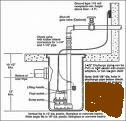Waterproofing
Not all basement leaks are alike. It is difficult for homeowners to choose the correct waterproofing system. A dry basement is one of your best investments. It also offers added living space your family will enjoy for years to come. Basement leakage can result in serious weakness in the foundation, causing the foundation to settle and cause further damage. Water leakage and soil condition can also cause buckled walls, and a deterioration of the basement structure itself. The money you invest on a dry, strong basement will be the most important decision you make. Your foundation depends on it.
Waterproofing is needed anytime a structure is built at ground level or below ground. Waterproofing and drainage considerations are especially needed in cases where ground water is likely to build up in the soil and raise the watertable. This higher watertable causes hydrostatic pressure to be exerted underneath basement floors and against basement walls. Hydrostatic pressure forces water in through cracks in foundation walls, through openings caused by expansion and contraction of the footing-foundation wall joint and up through floor cracks. Hydrostatic pressure can cause major structural damage to foundation walls and is likely to contribute to mold, decay and other moisture related problems.
Methods
The three main measures developed to prevent this problem differ greatly in ideology and design. The first being interior wall and floor sealers. The other two methods are interior water drainage and exterior drainage combined with waterproofing coatings.
Interior Sealants
Interior sealers will not provide permanent protection from water infiltration where hydrostatic pressure is present. Interior sealers are good for preventing high atmospheric humidity inside the basement, from absorbing into the porous masonry and to prevent spalling. Spalling is a condition where constant high humidity or moisture break down masonry surfaces causing deterioration and shedding of the concrete surfaces.
Interior Water Drainage
Although interior water drainage is not technically waterproofing, it is a widely accepted technique in mitigating basement water and is generally referred to as a basement waterproofing solution. Many interior drainage systems are patented as well as recognized by B.O.C.A (Building Officials and Code Administrators)as being effective in controlling basement water. They function by draining underground water from alongside the foundation footers and underneath the basement floor. They then channel it with a French drain, PVC pipe, or through a patented product to a sump pump system, which will then pump the water from the basement. Foundation sump pumps can be installed through do-it-yourself kits, plumber installations, or by a professional waterproofing contractor and generally come in plastic and cast-iron models.
To simplify:
Water enters the home via the basement wall/floor joint, through cracks in the foundation walls and/or holes created by faulty or decaying masonry/brick.
A perimeter trench drain collects the water before it enters into the basement.
Wall vapor barriers/retarders and drip moldings are used and incorporated into the sub-slab perimeter drain to collect water coming from wall cracks and other foundation wall defects. The drain directs the water to a sump pump.
The sump pump ejects the water out of the house.
Interior basement waterproofing systems should be prepared to work in the case of a power outage, the failure of a sump pump, and in the face of overwhelming torrential rain. A proper sump pump, backup sump and/or battery backup sump pump should be installed in a large sump pit with an airtight lid for safety and to keep humidity from seeping through to the basement environment, where it can promote mold growth. This airtight practice will also reduce the possibility of dangerous radon gases entering the living space. Despite widespread sump pump failures, top-of-the-line sump pump systems are more reliable than ever.
Exterior Waterproofing
Exterior waterproofing prevents water from entering foundation walls therefore preventing the wicking and molding of building materials. Waterproofing a structure from the exterior is the only method the IBC (International Building Code) recognizes as adequate to prevent structural damage caused by water intrusion. Prior to the 1980's much of the original exterior waterproofing was actually damp-proofing using a degradable asphalt-based covering. Today, however, Polymer products such as Tremco's Paraseal membrane will completely waterproof an exterior foundation wall. This material has a half life in the thousands of years which makes it ideal for a long term exterior waterproofing solution. Asphalt and tar based compounds are affected by soil pH. and break down after 10-20 years, thus making that type of waterproofing ineffective over time.
Polymer Based Compounds
Over the past ten years, polymer-based waterproofing products have been developed. Polymer-based products last for the lifetime of the building, and are not affected by soil pH. Polymer-based waterproofing also has the advantage of a low enough viscosity that it can be sprayed directly onto a wall.
Basement Solutions
